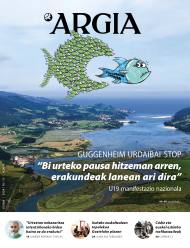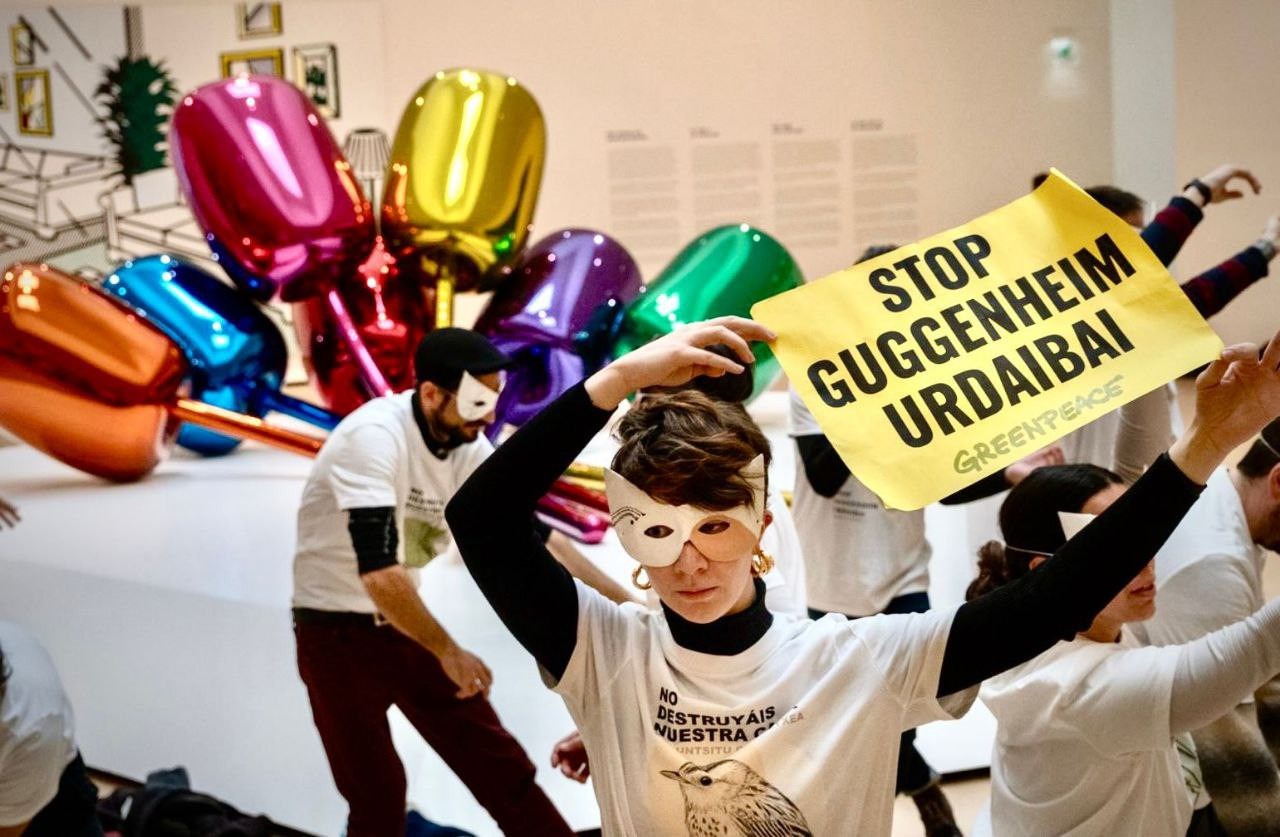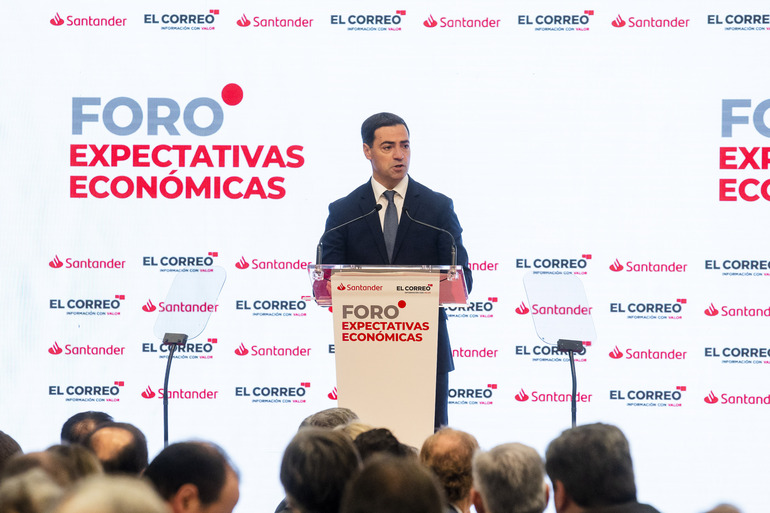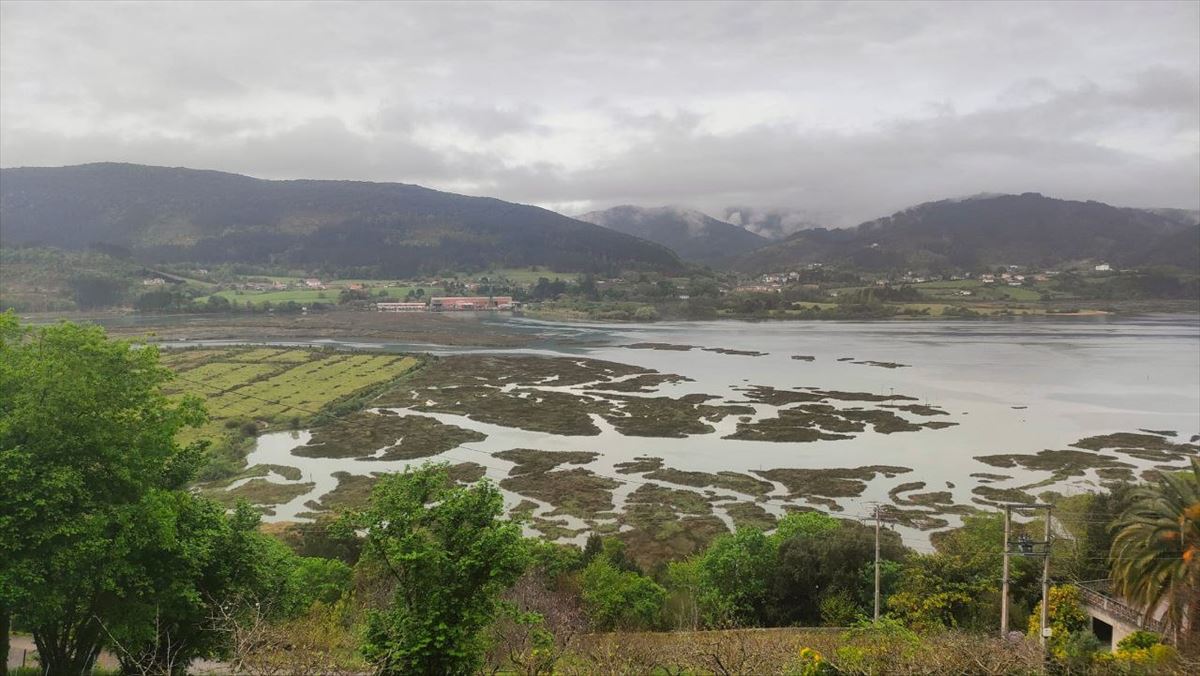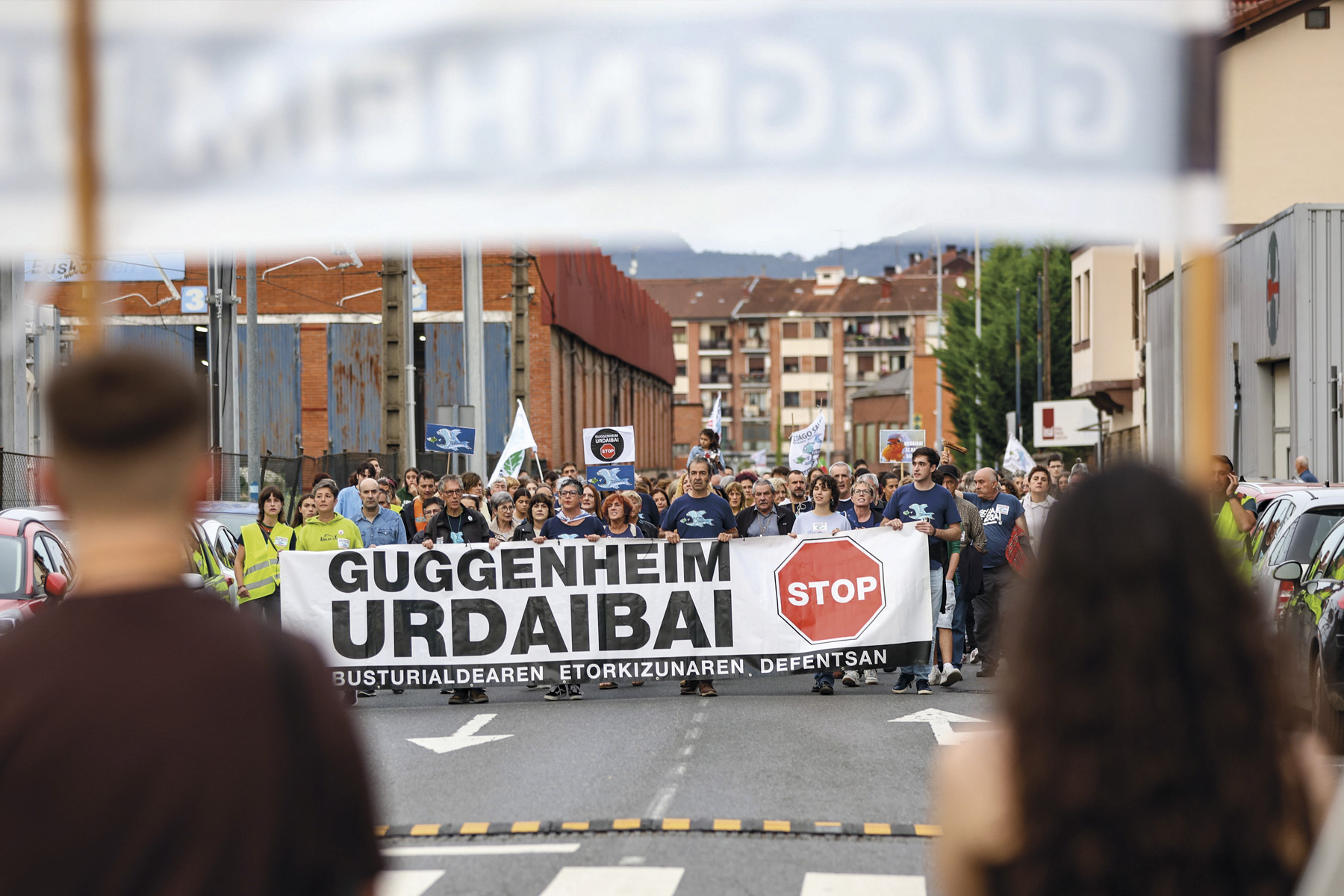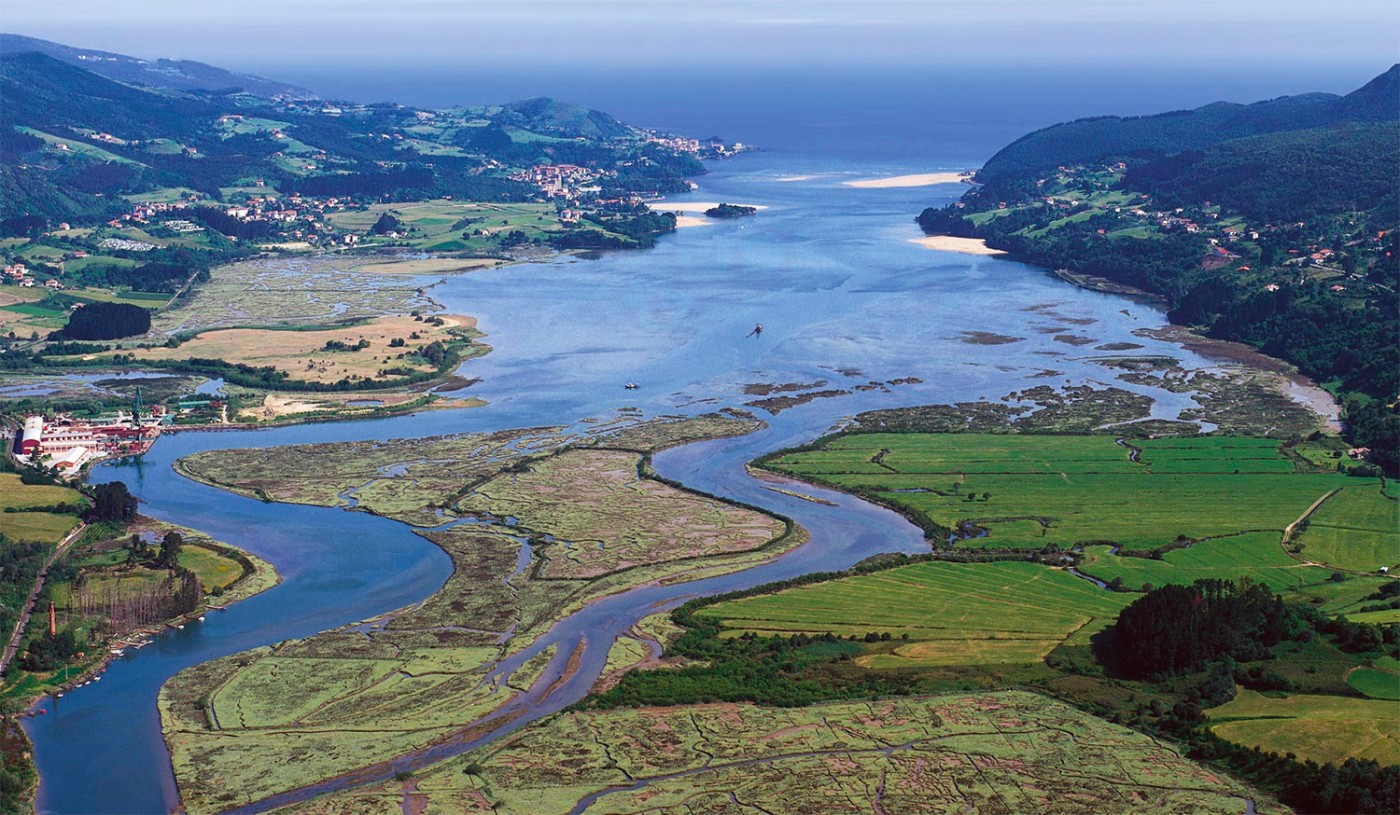Urdaibai vs Guggenheim
- The Basque Government and the Provincial Council of Bizkaia announced at the beginning of the year a “two-year period of reflection”, but it is not stagnating because public institutions are anticipating and fixing the obstacles they may have in the future. In addition, in the summer, the company Dalia has been demolished in Gernika, where the construction of one of the museums is planned. The Guggenheim Urdaibai Stop platform is working in three areas. Mainly, to know and inform about the hidden intentions and then to communicate them to the public and fight in the courts. They have convened a national demonstration for the next 19 October in Gernika, starting at 18:00.

This is Monday morning in Gernika. Market day. The appointment has been in Astra with members of the Guggenheim Urdaibai Stop citizen platform, who have come to the appointment. Three people have come to the ARGIA appointment: Eider Gotxi, a professor and activist at Bermeo who has been lecturing on the Guggenheim at Urdaibai; Txema García, a retired writer and journalist; and Gorka Barba, who is engaged in forging and environmental work.
Urdaibai Stop is a popular platform made up of neighbors and neighbors in the area and Urdaibai. A year ago a major mobilisation took place in Gernika – on the very day when a major mobilisation for Palestine was called – and a new popular mobilisation was organised by 19 October. The situation in Palestine has apparently not improved either the museum, which is in a delicate situation.
The members of the platform aim to gather information and disseminate it to the public. On the contrary, the Guggenheim project is characterised by a lack of information and transparency. Nobody knows what the project is. The members of the Provincial Council of Bizkaia state that the project must proceed yes or no. The draft is not available anywhere. The municipal officials have nothing clear about it, so the members of the platform continue to seek information, here and there, to make it reach the citizens. They've come together a lot and, faced with the obstacles along the way, they use this information to mobilize, to raise awareness and to paralyze the project.
.jpg)
The project will have two sites: In Gernika, one was the Dalia company; and in Murueta, the other was the shipyard of the Urdaibai estuary, which has been operating and polluting for decades. It is a walking link that has a length of more than four kilometers.
First blow: If there has
been any significant movement during the summer, that has been the knock down of the Dalia factory. That is, the physical base of the first of these two residences has begun to be prepared. They began the demolition in the second week of June, as Eider Gotxi explains, to give a “big boost” to the project.
“The dismantling of Dalia is a clear example that this museum project has taken its first steps,” explains Gotxi. He has given over a hundred conferences explaining the Guggenheim project in each village. Urdaibai ' s distress has spread to other parts of Busturialdea. And so far, what was feared, you've seen how steps are being taken to do it this summer. In front of your eyes, in Gernika.
Unexpectedly, the work of the large excavators in the centre of Gernika, parallel to the tracks of the train. No one had announced the work, but it was being done. In silence, but with a lot of noise; in summer the works have continued without interruption and have ended. And then the Dalia factory is torn down and the underlying waters will be cleaned up. Dalia was an internationally recognized company in the 1970s dedicated to the manufacturing of spoons and forks. It's been all the time polluted by the bottom water, full of asbestos.
The Bizkaia Infrastructure Deputy, Carlos Alzaga, has promised at the General Meetings that the aquifer will be cleaned and its “complete withdrawal”. Moreover, he said that they will do so, because the aim is for a “museum” to be installed in that place. Eider Gotxi says they don't have more information about it.
.jpg)
Second blow: The Director General
of the Guggenheim in Bilbao, Juan Ignacio Vidé, announced today, after 32 years, that he is withdrawing from the Guggenheim direction. Now they're looking for the next person to take their place. The selection process was announced in the spring, and the presentation of the new director general of the entity is expected to begin this autumn.
In a farewell interview, Vidado pointed out that the demolition of the Dalia factory of Gernika is "a clean-up of lands", but that the objective has not been a museum, but "can be compatible with other actions". But the members of the platform say that the Provincial Council of Bizkaia, as has already been mentioned, says the opposite, as Mr Alzaga has spoken in favour of the museum. “Even if they seem to contradict each other, we are clear that they are playing with citizenship.”
The clean-up of the underlying waters, before leaving the lehendakari position of the Basque Government in a two-year parentheses, met in
January of this year with the new Deputy General of Bizkaia, Iñigo Urkullu, Elixabete Etxanobe. On behalf of the board of the Guggenheim Bilbao, chaired by Etxanobe, he said that a "two-year period of reflection" was to be opened on the Urdaibai project. It was, therefore, a complete electoral cycle, “a moment of reflection”.
.jpg)
Txema García understands the matter differently: “It is nothing more than a two-year moratorium, because we are seeing every day that work is being done to overcome possible obstacles. Work is also under way in all areas. Working to deal with the difficulties, simplifying everything to get the project through. The reality is as follows: They have thrown Dalia and are moving in many other camps. Judicially, for example, steps are being taken to facilitate the museum’s project.”
The words of January seem to go by the wind; Urkullu is already lehendakari. Any spokesman of the Provincial Council of Bizkaia, in the presence of the press or in each of his speeches in the public radio stations, expresses his support for the project of Gernika and Murueta.
"This is not a regional issue; as this natural environment belongs to all, it is the responsibility of all Basques to defend"
Txema García considers that “for them this is viable from the very beginning” and “they will make it viable”. Eider Gotxi, for his part, pointed out that they do not want or think about the conclusions of the project: “They want it to be viable, yes or yes, in this region, without taking into account its consequences on the biosphere reserve.” Gotxi, for example, highlighted Dalia’s demolition report: “The steps required by the demolition procedure have not been followed. The work has been carried out in summer, in June the decisions have been made, they have been taken in the official gazette and the citizens have not noticed anything in summer.”
In any case, Eider Gotxi says that it is significant to bring down Dalia within two years: “That gives the project an appearance of reality, not what they say, but what they are doing.” For its part, Txema García and Gorka Barba see it clear: “Steps are being taken, but there is nothing done, the project does not exist, there are possibilities to stop it… and in that we are sharing the information we have, with the aim of contaminating the force contrary to the project”.
.jpg)
Taking advantage of the pause, to
work “The pause has been and will be a challenge for us,” says Gotxi: “All this time we want to keep people active, that’s where we are. It is difficult for the rulers to keep the issue to a close when they say that it will take two years for reflection. After two years of pause or reflection, it may be normal to think that the project is in question. But what we see is the opposite. As we have said, the project moves forward in the administrations.” For the members of the platform, therefore, the goal is for people to understand that the authorities say one thing in public, but that they are doing another in secret.
Garcia refers to the “narrate” of people: “We see a narrate process, they want to give a clean image with Dalia’s account, without linking it to the Guggenheim project. They are cleaning up the aquifer, removing asbestos… as if it were beneficial to the Gernikarras.” But he wants to make it clear that behind that the basis of the Guggenheim project is being laid. Demolish the factory to build the museum in it.
The advocacy work, the Guggenheim
Urdaibai Stop platform, is working not only on the street, but also on the judicial level. That is what Gorka Barba underlined: "That work isn't so clear, people don't notice all the work behind it, it's a work done with street mobilization," he added.
Eider Gotxi is optimistic in explaining the work they are doing in both the judicial and mobilisation fields: “Both fields go in parallel. We are working very well on the street, we know how to inform people, we are doing a great job on social media, but the area of the courts is out of our hands and with all confidence we are working with a team of lawyers. One camp cannot weaken the other, we have to reinforce both”.
"The two-year ban announced is a moratorium; we are seeing every day that work is being done to overcome any obstacles that may be encountered in the future"
The judicial route is complex. They have two open roads. The first is that relating to a supramunicipal convention: they have done so in Murueta, Forua and Gernika, signed between February and May 2023 by the mayors of the three constituencies. Gotxi explained that the administrations have to amend some urban planning plans and for this they need competition to be higher than the municipalities, in the hands of the Council. Gotxi has given more detailed explanations: "We made allegations to Murueta's PGOU. In fact, they want to change the rating of the soil where the Murueta shipyard is located, which is currently industrial, by equipment in the new one. If we were to get the allegation to flourish, a museum could not be built on industrial land.”
And second: The reform of the Coasts Law, also appealed to the Spanish National Court, has informed the Public Prosecutor’s Office today. On 8 October 2021, the Provincial Council of Bizkaia requested the Spanish Ministry of Transition to carry out the reduction of ownership from 100 to 20 meters. What for? According to Gotxi, they need a space to locate the museum. "They made it public in October 2023 and now everyone has realized that the cut has been executed and we have filed a complaint with him in which, besides being based on the origin of the Coast Act, there are some administrative errors. For example, the deadline for making the application and making it effective expired, for ten months,” says Gotxi.
In addition, there is another question: Who has to lawfully apply for such a reduction? The members of the platform have answered the question immediately: “Owners. And the Member tells us that the owner of these lands is currently the shipyard Astilleros de Murueta, even though he has initiated a purchase procedure. Therefore, the cut cannot yet be requested by the Member, who has a zero deficit. In this sense, the same request can also be considered null and void”.
.jpg)
National mobilization
"This is not a regional issue; as this natural environment belongs to all, it is the responsibility of all Basques to paralyse this project". They have announced the mobilisation of 19 October.
A response is being articulated at the level of the Basque Country. They are in contact with agents from all over the Basque Country, such as artists, sportsmen, members of popular movements, associations and initiatives for the environment, individuals and groups... Gotxi spoke with optimism: “We want to show that Busturialdea has something to say. We already demonstrated it a year ago, even if they have not listened to us very much, and we will repeat it, we will express it higher… We are sure that this year’s demonstration is going to be much bigger, we are already noticing it.” Precisely, according to the members of the platform, they are approaching their work and many people who last year were "far away" from it are interested.
In any case, they are clear that they have to keep reporting. “Who knows this project outside of Busturialdea?” Gotxi has been worried. A lot of the talks are giving the platform, especially Gotxi, and it's been noticed that it's hard for people to be interested in it. But they're getting it, at least the accessions. They say the list is endless.
In 2021 we began to hear the first echoes of the Guggenheim Urdaibai project. The then General Manager Unai Rementeria told us that it would be done yes or yes. To reinforce his claims, he left 40 million euros “shielded” by the time the museums were built. There it is!... [+]
Two years ago Urdaibai Guggenheim Stop! Since the creation of the popular platform, Urdaibai is not for sale! We hear the chorus everywhere. On 19 October we met thousands of people in Gernika to reject this project and, in my opinion, there are three main reasons for opposing... [+]









